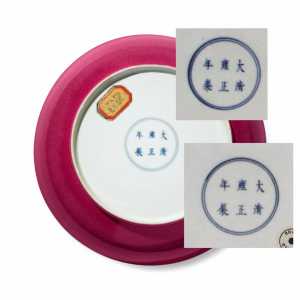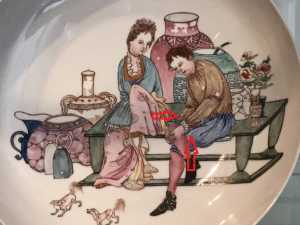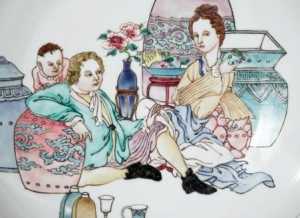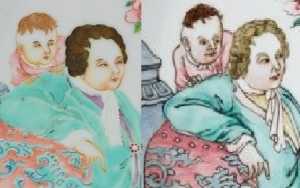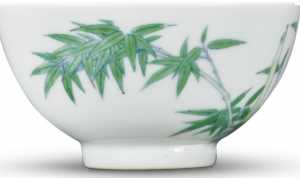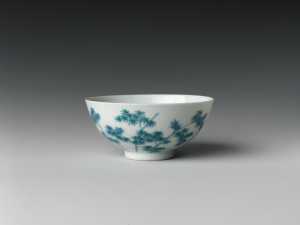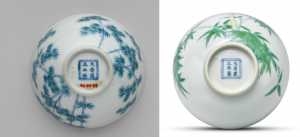The Chinese and Asian Art Forum. For Fans, Collectors and Dealers.
 Basic Rules For the BidAmount Asian Art Forum: Talk about whatever you want. You can even discuss and offer things that are for sale if they are authentic. Maximum image file size per post is 2 MB. Images of 700pxl x 700pxl are optimal if saved at a medium resolution. Be respectful of others and enjoy yourself. Click the YouTube link for a brief tutorial on using the forum. You can also EMBED Videos by cutting and pasting from You-Tube, Vimeo etc.
Basic Rules For the BidAmount Asian Art Forum: Talk about whatever you want. You can even discuss and offer things that are for sale if they are authentic. Maximum image file size per post is 2 MB. Images of 700pxl x 700pxl are optimal if saved at a medium resolution. Be respectful of others and enjoy yourself. Click the YouTube link for a brief tutorial on using the forum. You can also EMBED Videos by cutting and pasting from You-Tube, Vimeo etc.
NOTE: To post an item or add a new post, click open the category title from the FORUM LIST, and CLICK the Blue ADD TOPIC button.
@avatar So, I have to ask...
Comparing the Sotheby's example and the museum example, do you think they look equal in quality of rendering and color of enamel?
When comparing to the museums examples they appear to be pretty close but not identical. When comparing to the example at Sotheby's no but actually better. But that's just my opinion and you may have a different opinion and that's fine.
@greeno107 The part I am most curious about is Sothebys choice to sell them in the first place if in fact they are 20th C. Sothebys doesn't knowingly sell 20th C reproductions to my knowledge, so why did they do so in this case? Is it possible that we have entered a phase where 20th C reproductions are simply going to be openly valued at an extremely high level, and sothebys is making a statement about that by coming out to endorse these objects? This is a discussion we have been touching upon in the forum recently, with some having asked the question whether these more modern high level hand made reproductions are great works of art in their own right. I personally don't know enough about the manufacturing processes being used to have an opinion about it, but I am curious to hear what more educated members know about it, and I really hope someone in the know provides further insights into these recent sales results - people who bought or know the buyers, sellers, reps from the auction houses, etc. John
I compared the calligraphy of them. All of them match almost perfectly. I think they were made by the same person.
www.Wyssemaria-Art.com
[email protected]
Instagram: @wyssemaria_art
@xin_fawis Well, let's compare the fronts....
My eyes see two paintings far from each other from an artistic standpoint. The Sotheby's piece has a lack of detail, overly rounded/soft line work, some proportion issues in facial features, colors that appear to have not existed in the Yongzheng.
But, set aside the artistry and let's look at the nature of the enamel.
As you know, genuine famille rose enamels of the Yongzheng was applied in a relatively thick manner. The imperial kilns were exceptionally skilled, but still there were areas of thicker/thinner application and the process of firing these wares was new to them, which casused the enamel to bubble when fired.
On the left, you see the museum piece, and I've pointed out with red arrows a few of the many areas that the bubbling occured. In fact, there are so many spots of bubbling (shown by the white reflection in the photo), that I could have covered this photo with red arrows if I pointed all of them out.
On the Sotheby's piece... the glaze is so watery and thin, there are no bubbles. The only explination is that the enamels on the Sotheby's piece is A) fired completely differently than the museum piece, and/or B) the enamels are of completely different chemical material that it did not bubble.
Regarding the mark, I'm not sure I'd agree they are a perfect match, but regardless, it seems to me that copy a mark perfectly is far easier than copying an entire painting, but another explination could be possible.
The plate and mark are genuine, but the old decoration could have been removed, and the plate re-decorated at a later time a with 'rare' European design. This might also explain the differences in enamel quality.
The chemicals of modern enamels perhaps require lower temperatures to fire, so the risk of damaging the original porcelain is less, or perhaps none at all.
Is this a crazy conspiracy theory? Not entirely. We've all heard stories of refiring of antique porcelain parts (foot rim and mark of a genuine piece with the body of a modern piece), so this could be just one evelutionary step in the production of deceptive pieces.
My point is that these extra high sales results seem to push a narrative that we should accept less than exceptional (perfect) rendering on the basis of A) 95% looking correctly rendered, and B) provenance.
This is an unscientific approach and should be carefully re-evaluated.
Condiser the situation that exists with 20th c. paintings, and the frequency that the living artists have encountered fakes hanging in museums and listed as authentic.
We simply can not keep lowering the bar on the quality of rendering....it will destroy the industry.
@johnshoe Auction houses are obviously liable for selling reproduction as genuine, but nothing precludes them from selling a reproduction listed as such, and if buyers want to pay extraordinary amounts more for it, so be it.
I suspect the wilingness to accept such a piece had more to do with the source - they are not going to refuse a consignment from a client who has regularly given them good pieces and risk damaging a relationship.
This is purely my opinion...I have no inside info on the true reason.
@greeno107 The thing is, Sotheby's doesn't sell 20th C reproductions historically, so why would any consigner even think to be annoyed with them for refusing to do so? It appears to me that Sotheby's has made a conscious decision to change what they are willing to sell, and that's a pretty big decision with implications regarding the issue of lowering/changing the standards that you just alluded to in your other post. And the bigtime results seem to be a little too perfect of a result for such a new change in the game, so the whole thing seems not that believable. I mean, Sotheby's out of the blue decides to sell some 20th C reproductions with very lowball estimates and they all go for 6 figures. Why would collectors even go for it? It seems to make more sense that these are authentic older pieces that were mislabelled. But that seems absurd as well given the thorough process Sothebys is said to go through to authenticate. Really, from what I can see, there is no good explanation for what happened because all the possible reasons lead to troubling conclusions. It seems like a mess that's going to be hard to clean up.
So, let's take a close look at the very similar theme of the Qianlong plate and the Sotheby's 'Yongzheng' plate...
Ask yourselves this.... If someone posted this image on the Forum and asked, are these scenes are both 18th c., would you tell them yes?
No you would not.
Quite honestly, I can not believe that the differences in quality is not painfully obvious to everyone.
The thing is, Sotheby's doesn't sell 20th C reproductions historically
That is not what Sotheby's did. The pieces were sold as 20th...no mention of being reproductions or otherwise, and yes, if you look a bit you will find that all the major auction houses have at one point or another sold 20th c. porcelains for their best clients.
The low estimate is further evidence. Had they valued the piece above what legally would be considered 'decorative value', they could be held liable for misleading the buyer.
Sotheby's and all other auction houses go through the same method of authentication (based upon personal experience) and mistakes happen. There was no mistake here....they listed the pieces as 20th c. (my opinion), so therefor no liability.
No doubt, as others have already done here in this post, some collectors will point to similar themes, matching mark, and examples of less than perfect renderings & variations of European subject matter on non-imperial wares as evidence of authenticity.
This is a bad practice, in fact, it contradicts everything we teach here to new members.
For a piece to be genuine, there needs to be a perfect 'marriage' of quality and materials for the period that the piece is attributed to for it to be correct. That clearly does not exist here, and I'm not sure why this golden rule is now being ignored.
By the way...
The emperor in the book, "The Emperor's New Clothes", is actually naked.
Just a simple man's opinion.
Tim
Dear Greeno,
Thank you for great feedback. First I have to apologize for my limited language ability. English is not my mother tongue, so it is difficult for me to express properly. You have written a lot which is very interesting for me to read. But I would not answer all your questions or explain everything I know since my spare time is also very limited.
Yes, you're right with your points on rendering, material comparison and so on. I agree with you too. I didn't handle this dish in person and I can't really judge this to be 100% genuine. I have provided my personal opinion here based on my limited experience and the information I have received. I posted a preview video of this dish. I can see the enamel, and there is indeed difference. But for me the big picture is more important than details.
Refiring is very risky. IMO the body of this dish is of the period and the mark too. It's already expensive enough. And I don't think you have a lot of geniue dishes to experiment with enamels. You have a very complicated case here, ruby back and front picture. It's not easy to make both perfectly. To reproduce all technique you have to invest a lot.
I have read discussions on Chinese platform. People there also have different opinions. This kind of wares are rare. If I hadn't seen them at the museum, I wouldn't have any idea about them. So I would do more research on this theme.
I will talk to you later if I have more time.
Xin
www.Wyssemaria-Art.com
[email protected]
Instagram: @wyssemaria_art
I am with Greeno here on many points.
The results of the big auction houses sales are not worth to be considered in many cases.
For many different reasons.
It is a proven, several times proven, fact that they do sell fakes too.
It is a fact that the knowledge of they experts is in many cases ridiculous. I have myself experiences that you would not believe.
It is also ridiculous their adoration for the God Provenance.
It is a fact that THEY SELL WHAT THEY WANT, TO WHOM THEY WANT, AND AT THE PRICE THAT THEY WANT. I have personal proves of that.
It is a fact that they accept items from whom they want. How many times do they tell you that your item is not reaching the minimum threshold of 10,000 dollars and then you see items listed by them with a starting price of 500 or 1,000 dollars?
It is also a fact that there is an abysmal ignorance among big pocket buyers, and these are their preferred customers.
There is a sort of mafia between the auction houses, some big dealers and a bunch of big buyers. It is a close circuit. That is especially evident in the snuff bottles field, more evident than the Sunrise.
Giovanni
Thanks for your posts, Tim. As one who agreed about the broken vase, I found this very interesting, too. My first thought on seeing the Sotheby's plate was how stiff the figures look. Aside from any other differences, you can see with the images close to each other, how much more natural and supple the museum figures are. It has a better flow, too.
I want to revisit the early post by Xin regarding the Sotheby's 'bamboo' bowl. Here is a link to the MET Museum's Yongzheng 'bamboo' bowl. The bowl is essentially of equal size.
https://www.metmuseum.org/art/collection/search/51040
Now, there is some variation in the rendering of other Yongzheng 'bamboo' bowls in that they don't all have exactly the same scene of bamboo, but what is consistant is the fineness of the bamboo stalks, the manner that they extend beyond the rim of the bowl, the delicate angles of the stalks, and the brilliance of the color of the doucai enamels.
You judge for yourselves....
This is Sotheby's piece listed as 20th c. but sold as if of the period.
This is the MET Museum example, a genuine Yongzheng example. (remember, these are the same size)
And here's a close-up of the two that I was able to compose on my photoshop...
The photoshop comparison I make is a fairly good comparison in that I made the bowls equal in size, as they genuinely are. The rendering is substantially over-simplified in the Sotheby's example, leaves are bulky, and the color comparison has the Sotheby's example looking more like a famille verte than the glowing doucai that is expected for Yongzheng (as shown in the MET example).
Not convinced? Look at a comparison from a bottom view...
Again, I don't see the marks as the same, but setting aside the marks, these bowls look dramatically different in style and color for two bowls of the same very short period of time in the early 18th c.
I think Sotheby's made a good call on describing as 20th c.
Thanks for visiting "The BidAmount Asian Art Forum | Chinese Art"
If you sell on eBay, or have a shop feel free to post images and descriptions and links.
Check back often for discussion about the latest news in the Chinese art and antique world. Also find out about the latest Asian art auctions at Sotheby's, Christie's, Bonhams and Tajans.
Auction results for: fine porcelain, ceramics, bronze, jade, textiles and scholar's objects. As well as Japanese, Thai, Vietnamese and other Asian cultures.
Thank you,
Peter Combs
Topics and categories on The BidAmount Asian Art Forum | Chinese Art
Kangxi vases, Kangxi dishes and chargers, Kangxi ritual pieces, Kangxi scholar's objects, Qianlong famille rose, Qianlong enamels, Qianlong period paintings, Qianlong Emporer's court, Fine porcelain of the Yongzheng period. Chinese imperial art, Ming porcelain including Jiajing, Wanli, Xuande, Chenghua as well as Ming jades and bronzes.
The BidAmount Asian Art Forum | Chinese Art
A free Asian art discussion board and Asian art message board for dealers and collectors of art and antiques from China, Japan, Korea, Thailand, Cambodia, Vietnam and the rest of Asia. Linked to all of the BidAmount Asian art reference areas, with videos from plcombs Asian Art and Bidamount on YouTube. Sign up also for the weekly BidAmount newsletter and catalogs of active eBay listing of Chinese porcelain, bronze, jades, robes, and paintings.
The art of calligraphy - and for the ancient Chinese it certainly was an art - aimed to demonstrate superior control and skill using brush and ink. Calligraphy established itself as one of the major Chinese art forms during the Han dynasty (206 BCE - 220 CE), and for two millennia after, all educated men were expected to be proficient at it.
The Museum’s collections of Asian art span nearly five millennia and encompass the cultures of China, the Himalayas, India, Japan, Korea, and Southeast Asia. In 2007, the Museum launched an initiative to create dedicated galleries for the collection, beginning with a gallery for the arts of Korea ...
Chinese art is full of symbolism, in that artists typically seek to depict some aspect of a totality of which they are intuitively aware.
China Online Museum is the finest online museum of Chinese art. It features Chinese calligraphy, painting, ceramics, bronzes, carving, and other artworks.
Chinese Ceramics & Works of Art. Overview Upcoming auctions Contacts Auction results ... Christie’s sales of Chinese ceramics and works of art showcase centuries of Chinese history. Held throughout the year in London, New York, Paris and Hong Kong, they attract a wide audience of collectors and connoisseurs vying for pieces as diverse as ...
Explore Asian Art Week. Contact the Specialist Department. Chinese Paintings ... Senior Specialist, Head of Sale. [email protected]. Tel:+1 212 641 5760. Bid in-person or online for the upcoming auction:Fine Chinese Paintings on 10 September 2019 at New York. Bid in-person or online for the upcoming auction:Fine Chinese Paintings on 10 ...
Discover an abundance of must-see art from all corners of a vast continent at Christie’s NY Asian Art Week. From contemporary classical and Chinese paintings to works with exemplary provenance from the Art Institute of Chicago, our Rockefeller Paza galleries will be full of ancient treasures and contemporary masterworks in a salute to the vibrant arts of Asia.
Sold to benefit The Art Institute of Chicago’s Asian Art Acquisition Fund, the sale features 84 lots with a focus on Ming and Qing porcelains, and offers a rare insight into the taste for collecting Chinese ceramics and works of art in the Midwest from the end of the 19th century through the 1980s. Highlights include two Wanli wucai garlic-head vases, a Qianlong mark and period, blue and ...
Specialist, Chinese Paintings, Christie's London Dr Malcolm McNeill is a Specialist in Chinese Paintings at Christie’s, based in London. He previously worked as an assistant curator of the Chinese collections and the Victoria and Albert Museum in London, as a researcher at the British Museum, and as a translator and tour guide at the National Palace Museum in Taipei.
The Christie's Education 2020 Conference: The Chinese Art Market 18 Jun 2019 Christie’s Education is delighted to announce our first international academic conference in Asia which will take place in Hong Kong from 26-27 November 2020 at the Hong Kong Convention and Exhibition Centre and will run in parallel with Christie’s Hong Kong Autumn Auctions.
The summer Chinese Art sale in Hong Kong will feature works of art from several private collections, including Qing porcelains and textile from the collection of the legendary Chinese art dealer A. W. Bahr (1877–1959), fine gilt bronze Buddhist sculptures from an old Hong Kong collection, an East Asian collection of Qing dynasty wine cups and jades, and a Japanese collection of Song ceramics ...
Sotheby's Chinese Works of Art Department holds two auctions each year in London, New York, Hong Kong and Paris.
Chinese Art - View Auction details, bid, buy and collect the various artworks at Sothebys Art Auction House.
With more than 340 Chinese works of art dating from the Neolithic to the Republic periods, highlights of this sale include a selection of Qing Imperial monochromes from the collection of Arnold and Blema Steinberg, early ceramics from the Art Institute of Chicago and Chinese porcelain and works of art from the collection of Henry Arnhold.
Results: Sotheby's Asia Week achieved $52.4 million in six strong auctions, exceeding pre-sale estimates. With 76.5% of lots sold and 60.3% of lots surpassing high estimates, the Asian art sales at Sotheby's indicate continued collector interest in the finest works of art from China, India and and the Himalayas.
Today's sale of Important Chinese Art will proceed as planned with sessions at 10 AM and 2 PM EDT. Sotheby's will be monitoring the weather conditions throughout the day and will be available to coordinate alternative bidding options should conditions make it difficult for clients to attend the auction in person.
Bonhams Chinese Art department is renowned for offering the finest works of art representing the richness and breadth of China's artistic heritage, particularly Imperial porcelain, white and spinach green jades, cloisonné and Buddhist art. Specialised international auctions are held globally, including London, Hong Kong and San Francisco.
Bonhams : Chinese Works of Art We use cookies to remember choices you make on functionality and personal features to enhance your experience to our site. By continuing to use our site you consent to the use of cookies. Please refer to our privacy and cookie policies for more information.
Bonhams Fine Art Auctioneers & Valuers: auctioneers of art, pictures, collectables and motor cars. We use cookies to remember choices you make on functionality and personal features to enhance your experience to our site. By continuing to use our site you consent to the use of cookies. ... Chinese Art (US) General enquiries
Bonhams : Fine Chinese Art We use cookies to remember choices you make on functionality and personal features to enhance your experience to our site. By continuing to use our site you consent to the use of cookies. Please refer to our privacy and cookie policies for more information.
Bonhams Fine Art Auctioneers & Valuers: auctioneers of art, pictures, collectables and motor cars Bonhams : Asian Art We use cookies to remember choices you make on functionality and personal features to enhance your experience to our site.
Bonhams are international auctioneers of fine Chinese and Japanese art. We specialise in rare Imperial and Export Chinese ceramics and works of art, as well as Japanese ceramics, fine and decorative works of art from the Neolithic Period to the 20th century. View on map
Bonhams Fine Art Auctioneers & Valuers: auctioneers of art, pictures, collectables and motor cars. We use cookies to remember choices you make on functionality and personal features to enhance your experience to our site. By continuing to use our site you consent to the use of cookies. ... Asian Art Bonhams. Work. 22 Queen St.
